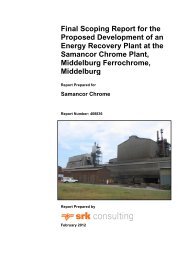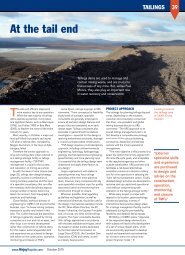Draft Status Quo Report for the Pixley Ka Seme ... - SRK Consulting
Draft Status Quo Report for the Pixley Ka Seme ... - SRK Consulting
Draft Status Quo Report for the Pixley Ka Seme ... - SRK Consulting
You also want an ePaper? Increase the reach of your titles
YUMPU automatically turns print PDFs into web optimized ePapers that Google loves.
<strong>SRK</strong> <strong>Consulting</strong> in association with BKS<br />
<strong>Pixley</strong> <strong>Ka</strong> <strong>Seme</strong> Local Municipality EMF – <strong>Draft</strong> <strong>Status</strong> <strong>Quo</strong> <strong>Report</strong> Page 10<br />
means of meeting <strong>the</strong>ir targets by way of three marketbased<br />
mechanisms. The Kyoto mechanisms are:<br />
The Montreal Protocol on Substances that Deplete<br />
Ozone Layer is a protocol under <strong>the</strong> Vienna<br />
Convention. The Protocol controls <strong>the</strong> production and<br />
consumption of <strong>the</strong> most commercially and<br />
environmentally significant ozone-depleting substances<br />
– those listed in <strong>the</strong> Annexes to <strong>the</strong> Protocol. One<br />
feature of <strong>the</strong> Montreal Protocol which makes it unique,<br />
is Article 6 that requires <strong>the</strong> control measures to be<br />
revised at least every four years (starting 1990), based<br />
on <strong>the</strong> review and assessment of latest availablein<strong>for</strong>mation<br />
on scientific, environmental, technical and<br />
economic aspects of <strong>the</strong> depletion of <strong>the</strong> ozone layer.<br />
• Emissions trading – known as “<strong>the</strong> carbon market";<br />
• The Clean Development Mechanism; and<br />
• Joint Implementation.<br />
These mechanisms help stimulate green investment and<br />
help Parties meet <strong>the</strong>ir emission targets in a costeffective<br />
way.<br />
The Vienna Convention <strong>for</strong> <strong>the</strong> Protection of<br />
<strong>the</strong> Ozone Layer<br />
The ultimate objective of <strong>the</strong> Convention is to protect<br />
human health and <strong>the</strong> environment against adverse<br />
effects resulting from human activities modifying <strong>the</strong><br />
ozone layer and urges <strong>the</strong> Parties to take appropriate<br />
measures in accordance with <strong>the</strong> provisions in <strong>the</strong><br />
Convention and its Protocols which are in <strong>for</strong>ce <strong>for</strong> that<br />
Party. To achieve <strong>the</strong> a<strong>for</strong>ementioned objectives, <strong>the</strong><br />
Parties, within <strong>the</strong>ir capabilities, are expected to:<br />
• Cooperate to better understand and assess <strong>the</strong><br />
effects of human activities on <strong>the</strong> ozone layer and<br />
<strong>the</strong> effects of <strong>the</strong> modification of <strong>the</strong> ozone layer;<br />
• Adopt appropriate measures and cooperate in<br />
harmonizing appropriate policies to control <strong>the</strong><br />
activities that are causing <strong>the</strong> modification of <strong>the</strong><br />
ozone layer;<br />
• Cooperate in <strong>the</strong> <strong>for</strong>mulation of agreed measures<br />
<strong>for</strong> <strong>the</strong> implementation of this Convention; and<br />
• Cooperate with competent international bodies to<br />
effectively implement this Convention and o<strong>the</strong>r<br />
protocols to which <strong>the</strong>y are party.<br />
The Montreal Protocol on Substances that<br />
deplete <strong>the</strong> Ozone Layer<br />
The Stockholm Convention on Persistent<br />
Organic Pollutants<br />
The Stockholm Convention is an international legally<br />
binding agreement on persistent organic pollutants<br />
(POPs). In 1995, <strong>the</strong> Governing Council of <strong>the</strong> United<br />
Nations Environment Programme (UNEP) called <strong>for</strong><br />
global action to be taken on POPs, which it defined as<br />
“chemical substances that persist in <strong>the</strong> environment,<br />
bio-accumulate through <strong>the</strong> food web, and pose a risk of<br />
causing adverse effects to human health and <strong>the</strong><br />
environment”.<br />
Following this, <strong>the</strong> Intergovernmental Forum on<br />
Chemical Safety and <strong>the</strong> International Programme <strong>for</strong><br />
Chemical Safety prepared an assessment of <strong>the</strong> 12 worst<br />
offenders. Known as <strong>the</strong> Dirty Dozen, this list includes<br />
eight organo-chlorine pesticides: aldrin, chlordane,<br />
dichlorodiphenyltrichloroethane (DDT), dieldrin,<br />
endrin, heptachlor, mirex and toxaphene; two industrial<br />
chemicals: hexachlorobenzene and <strong>the</strong> polychlorinated<br />
biphenyl group; and two groups of industrial byproducts:<br />
dioxins and furans.<br />
The Convention entered into <strong>for</strong>ce on 17 th May, 2004<br />
with ratification by an initial 128 parties and 151<br />
signatories. Co-signatories agreed to outlaw nine of <strong>the</strong><br />
"dirty dozen" chemicals, limit <strong>the</strong> use of DDT to<br />
malaria control, and curtail inadvertent production of<br />
dioxins and furans. Parties to <strong>the</strong> Convention have<br />
agreed to a process by which POPs can be reviewed and<br />
added to <strong>the</strong> Convention, if <strong>the</strong>y meet certain criteria <strong>for</strong><br />
persistence and trans boundary threat. Several o<strong>the</strong>r<br />
substances are being considered <strong>for</strong> inclusion in <strong>the</strong><br />
Convention, and include: hexabromobiphenyl,<br />
octaBDE, pentaBDE, pentachlorobenzene, shortchained<br />
chlorinated paraffin’s, lindane, α- and β-<br />
hexachlorocyclohexane, dicofol, endosulfan,<br />
chlordecone and PFOS.<br />
The Convention sets out several objectives including:<br />
• The elimination from commerce of identified POPs<br />
and o<strong>the</strong>rs that may be identified in <strong>the</strong> future;<br />
• Encouraging <strong>the</strong> transition in commerce to safer<br />
alternatives;<br />
• Identifying additional POPs;<br />
KILI/BEAT G:\404946_PIXLEY EMF\7REPORTS\<strong>Status</strong> <strong>Quo</strong> report\<strong>Draft</strong> report\<strong>Draft</strong> status quo report, July 2010.docx July 2010









